Building a home gym is a liberating choice, offering you the flexibility to work out on your own terms. No more time wasted commuting to a fitness centre, you can now exercise whenever it suits you, right at home. Whether you’re aiming to save money on long-term gym memberships, create a private workout space, or simply want the freedom of exercising in your comfort zone, a home gym offers countless benefits.
This step-by-step guide will walk you through everything you need to know about building a home gym. From selecting the right space and budgeting for your setup to designing the perfect layout, choosing the right equipment, and even adding inspiring décor. By the end, you’ll have a clear roadmap for creating a space that keeps you motivated and suits your lifestyle.
The best part? You can personalize every aspect, regardless of your budget or available space, to create a unique and inspiring workout space.
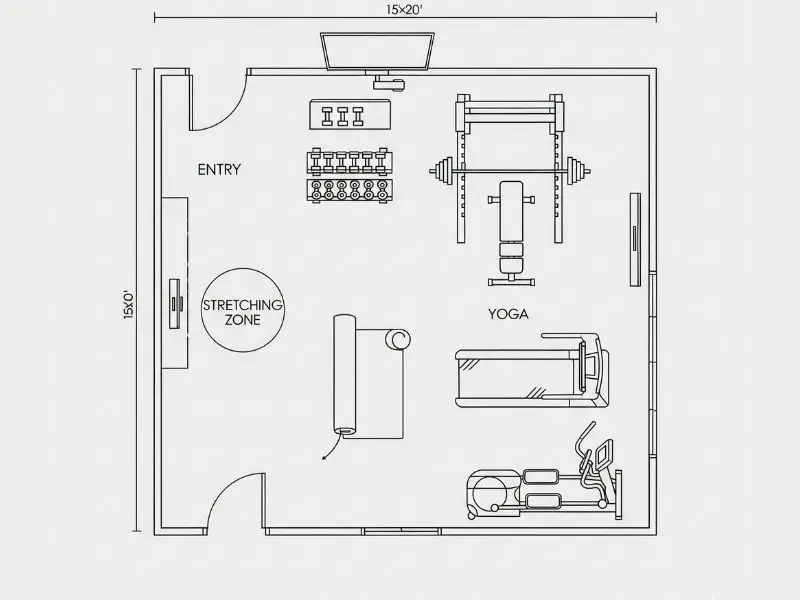
What You’ll Learn
- 1 Step 1 – Planning Your Home Gym
- 2 Step 2 – Designing the Layout
- 3 Step 3 – Flooring & Walls
- 4 Step 4 – Essential Equipment
- 5 Step 5 – Home Gym Décor & Atmosphere
- 6 Step 6 – Special Setups & Inspiration
- 7 Step 7 – Safety & Maintenance
- 8 Step 8 – Cost Comparison: Home Gym vs Gym Membership
- 9 Conclusion
- 10 FAQs
Step 1 – Planning Your Home Gym
Before buying equipment or painting walls, the first step in making a home gym is to plan carefully. Choosing the right location and setting a budget will determine the effectiveness and sustainability of your setup.
Choosing the Right Space
Not every home has a dedicated room for fitness, but the beauty of a home gym is that it can be built almost anywhere. Here are a few common options:
- Home Gym Room (Spare Bedroom) – Ideal for those seeking a clean, quiet, and climate-controlled workout space. Best for yoga, bodyweight training, and compact equipment.
- Garage Gym Ideas – Garages are popular because they offer high ceilings, plenty of space for heavy equipment, and easy ventilation. Perfect for powerlifting setups, squat racks, and cardio machines.
- Home Basement Gym – Basements are ideal for noise control and privacy. You can install a full rack, weights, and flooring without disturbing others.
- Home Gym in Garden Shed – If you love the outdoors, a shed can be transformed into a private training studio. It’s compact yet cosy, making it ideal for resistance bands, dumbbells, and stationary bikes.
Budget & Cost
One of the most common questions people ask is: How much does a home gym cost? The truth is, it depends on your goals and the type of equipment you choose. Here’s a breakdown:
- Budget Setup ($200–$500): Resistance bands, yoga mat, adjustable dumbbells, and a stability ball. Perfect for beginners or small spaces.
- Mid-Range Setup ($800–$1,500): Add a bench, barbell set, squat stand, and cardio equipment, such as a rowing machine or stationary bike.
- Advanced Setup ($2,000+): Full power rack, Olympic weightlifting bar, cable machine, treadmill or elliptical, and smart gym technology.
Instead of buying everything at once, start small with essentials and expand as your fitness journey grows. This keeps costs manageable while still allowing you to enjoy the benefits of training at home.
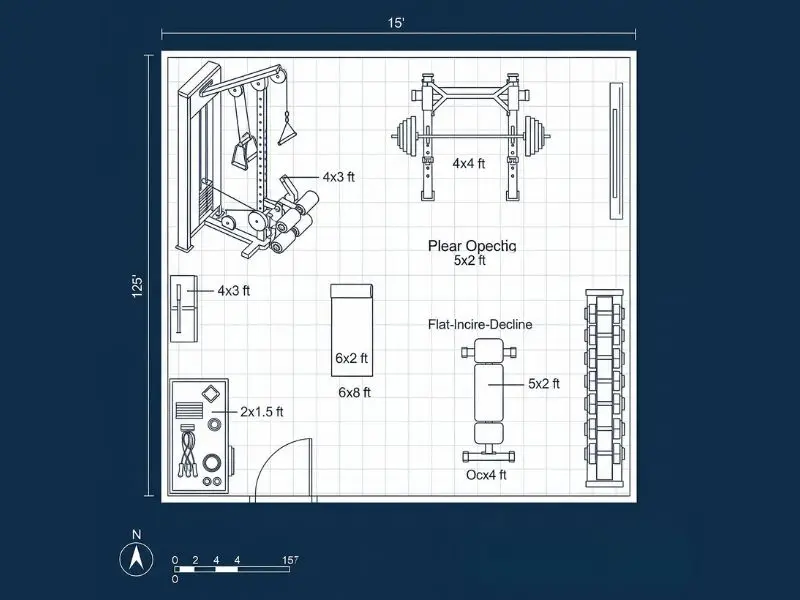
Step 2 – Designing the Layout
Once you’ve chosen your space and set a budget, the next step in building a home gym is designing the layout. A well-planned setup not only makes your workouts more effective but also keeps the space organized, safe, and motivating.
Think in Training Zones
The easiest way to organize your home gym is to divide it into zones. This ensures you’re not tripping over equipment and that each workout feels structured.
- Strength Zone: Place your squat rack, barbells, dumbbells, or kettlebells here. If you’re short on space, wall-mounted racks and foldable benches are excellent 2025 solutions.
- Cardio Zone: Treadmills, rowing machines, or stationary bikes work best near a power outlet. In small spaces, consider compact options, such as under-desk treadmills or foldable bikes.
- Mobility & Recovery Zone: Leave open floor space for yoga, stretching, and foam rolling. Even a simple mat area can make your gym feel complete.
- Storage Zone: Invest in vertical storage racks, wall hooks, or multi-tier dumbbell stands to keep clutter off the floor. Smart storage is one of the biggest trends in 2025 home gym design.
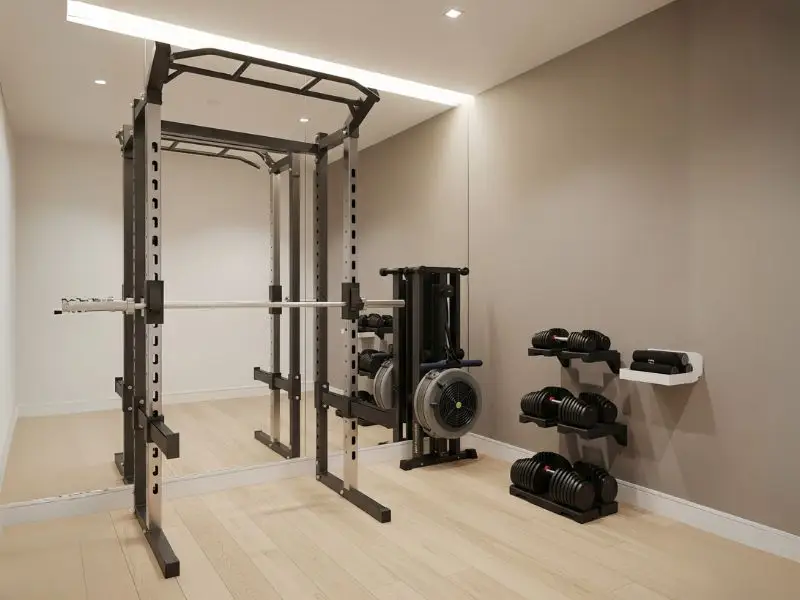
Home Gym Layout for Small Spaces
Not everyone has a full room or garage for their setup. If you’re looking for home gym ideas for small space, here are some updated strategies:
- Foldable Equipment: Look for foldable benches, collapsible squat racks, and adjustable dumbbells that replace multiple weight sets.
- Wall-Mounted Solutions: Wall-mounted racks, TRX systems, and pulley stations save valuable floor space.
- Mirror Illusion: Adding large mirrors not only helps check form but also makes a small gym look twice as big.
- Compact Cardio: Replace bulky treadmills with compact machines, such as foldable rowing machines or vertical climbers.
In 2025, brands are focusing heavily on multi-functional, space-saving gear—think benches with built-in storage or adjustable kettlebells. These options allow even apartment dwellers to enjoy a full workout without sacrificing living space.
Sample Layout Examples
- Garage Gym Layout: Place a squat rack against the wall, cardio machine near the door (for airflow), and storage racks along one side.
- Basement Gym Layout: Create separate corners—weights in one, stretching mats in another—to keep the area organized.
- Bedroom/Home Office Gym: Stick to portable gear like resistance bands, a yoga mat, and adjustable dumbbells that can slide under the bed or desk.
Extra Design Tips for 2025
- Use rubber tiles or interlocking mats to protect your floor and reduce noise.
- Install LED strip lighting for ambience, it’s a huge motivator and one of the most popular home gym design ideas this year.
- Keep a charging station for fitness trackers, phones, and Bluetooth headphones.
- Add a whiteboard or digital wall display to track your workouts and goals.
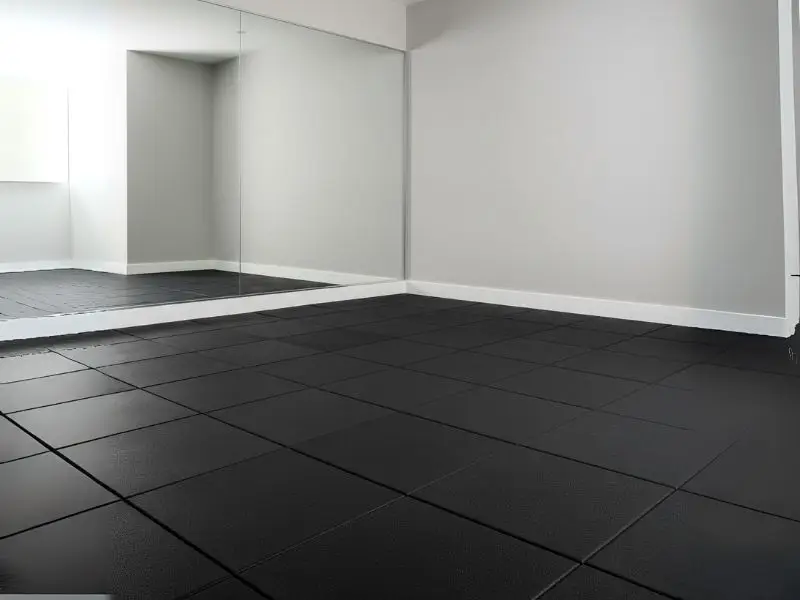
Step 3 – Flooring & Walls
Many people focus only on equipment when building a home gym, but the floor and walls are just as important. Good flooring protects your home, reduces noise, and improves safety. Meanwhile, the right wall setup and paint colors can completely transform the energy of your workout space.
Home Gym Flooring
Your flooring is the foundation of your gym. The right choice will absorb impact, prevent damage to your floors, and make workouts more comfortable.
Best Home Gym Flooring Options in 2025:
- Rubber Tiles (Most Popular): Durable, shock-absorbing, and easy to install. Available at stores like Home Depot, Amazon, or specialty fitness suppliers.
- Foam Mats: Lightweight and affordable. Great for yoga, Pilates, and bodyweight training, but less durable for heavy lifting.
- Vinyl Flooring: Water-resistant and easy to clean, ideal for basements and garages.
- Horse Stall Mats: A budget-friendly hack—thick, heavy-duty mats often used by weightlifters.
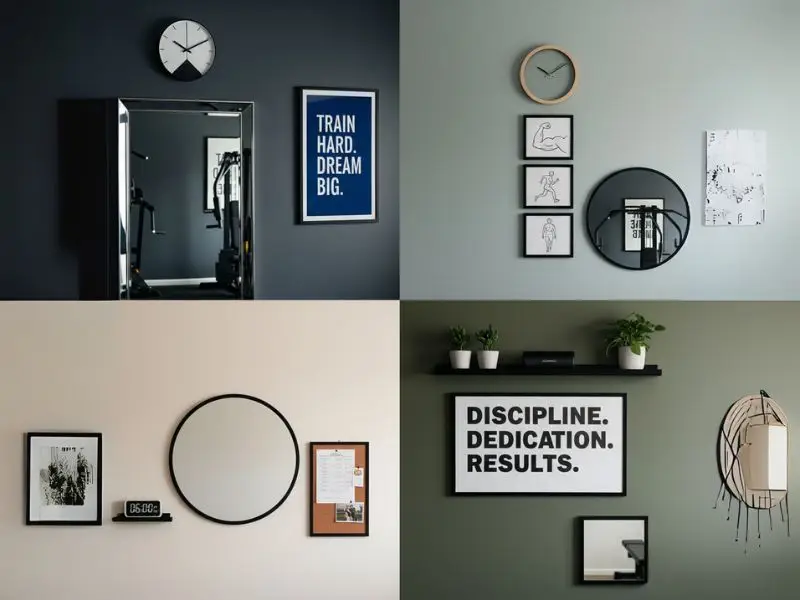
Wall Setup & Paint Colors
Your walls set the mood for your workout. Colors and design can influence motivation, focus, and even energy levels.
Popular Home Gym Paint Colors (2025):
- Bright Colors (Red, Orange, Yellow): Boost energy and intensity—great for cardio and HIIT workouts.
- Neutral Tones (Gray, White, Beige): Clean and modern, perfect for minimalist or small-space gyms.
- Dark Colors (Navy, Black, Deep Green): Create a sleek, focused training atmosphere, especially in garage gyms.
Wall Additions to Consider:
- Mirrors: Help with form checks, add depth, and make the room feel larger.
- Motivational Décor: Posters, decals, or digital screens with workout plans.
- Storage Solutions: Wall hooks for resistance bands, vertical racks for barbells, and mounted shelves for accessories.
- Smart Lighting: LED strips or smart bulbs can change colors for cardio, yoga, or lifting sessions.
Latest Wall Design Ideas for Home Gyms
- Wood Accent Walls: Adds warmth and character, popular in basement gyms.
- Chalkboard or Whiteboard Wall: Track progress, write workouts, or note goals.
- Soundproofing Panels: Great for reducing noise if you live in an apartment or share walls with neighbours.
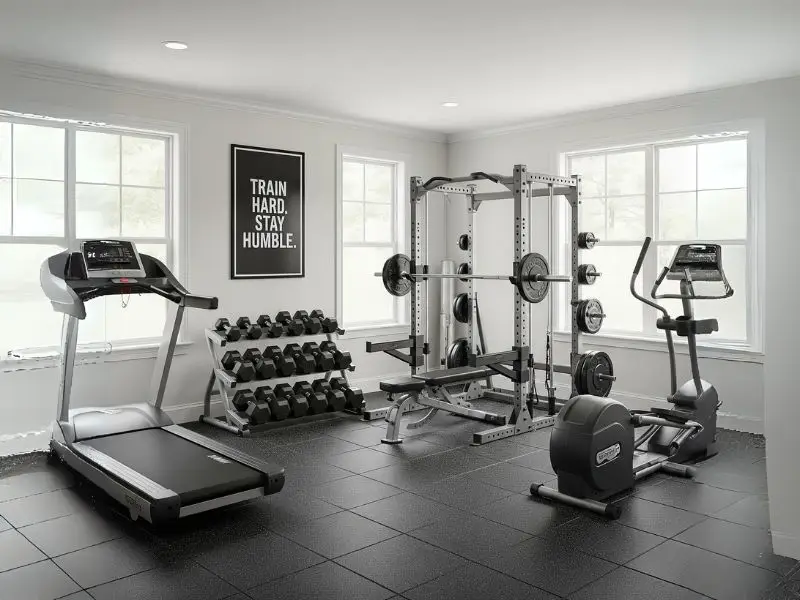
Step 4 – Essential Equipment
When it comes to building a home gym, the choice of equipment matters more than the quantity. Fitness experts recommend starting with versatile gear that covers strength, cardio, and mobility. This ensures you get a balanced workout routine without overcrowding your space.
Strength Training Essentials
Strength training is key for building muscle, improving metabolism, and supporting long-term joint health.
- Adjustable Dumbbells: Replace multiple sets of weights, saving money and space.
- Barbell & Weight Plates: The foundation for squats, deadlifts, and bench presses.
- Bench (Flat/Adjustable): Essential for pressing, step-ups, and core work.
- Kettlebells: Great for functional movements like swings, carries, and full-body conditioning.
- Pull-Up Bar: Supports upper-body and grip strength. Wall-mounted or doorway options fit small spaces.
Cardio Equipment
Cardio keeps your heart healthy, supports weight control, and improves endurance.
- Rowing Machine: Full-body, low-impact cardio with strength benefits.
- Stationary Bike: Compact and joint-friendly, ideal for interval training.
- Treadmill or Foldable Walking Pad: Great for home offices or garages, offering daily movement even on busy days.
- Jump Rope: Budget-friendly, portable, and excellent for quick cardio bursts.
Mobility & Recovery Tools
Recovery is often overlooked, but experts stress it’s essential for long-term results and injury prevention.
- Yoga Mat: For stretching, yoga, or bodyweight training.
- Foam Roller: Helps with muscle recovery, reducing soreness and improving flexibility.
- Resistance Bands: Perfect for warm-ups, rehab, and travel-friendly workouts.
Lifestyle Benefits of Essential Equipment
- Time Efficiency: No waiting for machines or commuting to a gym.
- Family-Friendly: Equipment like resistance bands, mats, and bikes can be used by all ages.
- Consistency: A well-equipped gym removes excuses and builds routine discipline.
- Cost Savings: Even a $1,000 investment can pay off in under two years, compared to monthly gym fees.
The best strategy is to start with multi-purpose, space-saving equipment and add specialized gear as your fitness grows. This keeps your home gym practical, motivating, and aligned with your health goals.
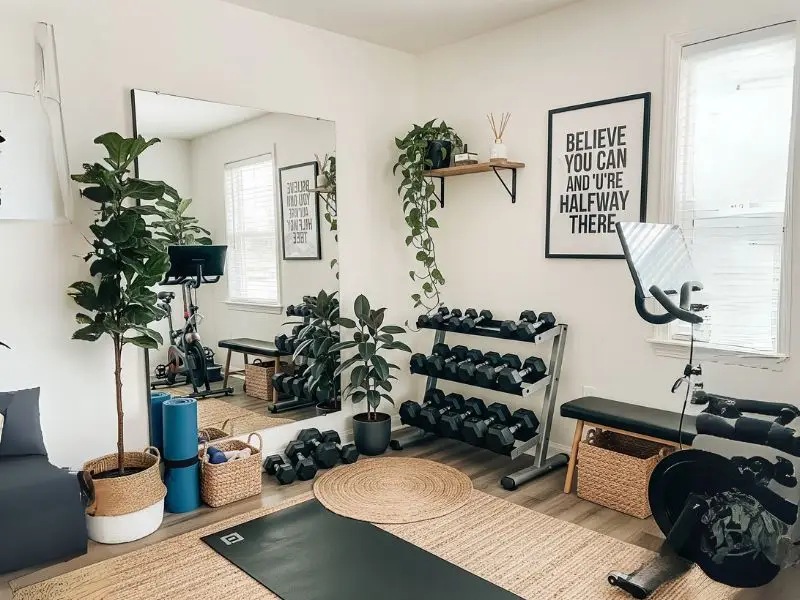
Step 5 – Home Gym Décor & Atmosphere
Your environment affects how consistent and motivated you’ll be. Studies in environmental psychology show that design elements like lighting, color, and décor can directly influence energy, focus, and mood during workouts. That’s why creating the right atmosphere in your home gym is just as important as the equipment itself.
Motivating Décor Ideas
- Wall Art & Motivation Boards: Posters or digital displays with quotes, progress charts, or workout plans create accountability.
- Mirrors: Not only improve form and safety but also make the space feel larger and brighter.
- Plants: Indoor greenery improves air quality and reduces stress levels during training.
Lighting & Atmosphere
Lighting plays a huge role in mood and energy levels.
- Natural Light: Whenever possible, set up your gym near windows for sunlight exposure—boosts Vitamin D and mood.
- LED Smart Lighting: Color-changing lights allow you to set “modes” — bright white for strength training, calming blue for yoga, or energetic red for cardio.
- Task Lighting: Focused lights near equipment improve safety in garage or basement gyms.
Sound & Atmosphere
- Bluetooth Speakers or Smart Displays: Music Enhances Motivation and Endurance.
- Noise Control: For basement or garage gyms, consider foam wall panels or rugs to reduce echoes and protect hearing.
- Headphones: A great option if you share your living space.
Organization & Functionality
- Wall Hooks & Racks: Keep resistance bands, jump ropes, and mats neatly stored.
- Multi-Purpose Shelves: Store towels, water bottles, or supplements within reach.
- Compact Storage Benches: Double as workout benches and storage for dumbbells or gear.
Keeping your gym organizedorganised reduces clutter, stress, and makes it easier to start workouts without friction.
Step 6 – Special Setups & Inspiration
One of the best parts of building a home gym is that it can be customized to fit your lifestyle, available space, and training style. Whether you have an entire garage or just a corner in your apartment, there’s a way to make it work. Here are some expert-approved setups to inspire your design.
Home Garage Gym Ideas
Garages are one of the most popular choices for home gyms. They’re spacious, have high ceilings, and can handle heavy equipment.
Key Features:
- Power racks and Olympic barbells fit well here.
- Rubber flooring or horse stall mats protect concrete floors.
- Good ventilation (open garage door or fan) keeps air fresh.
Home Basement Gym
Basements provide privacy and noise control, making them ideal for strength training or cardio workouts.
Key Features:
- Great for heavy lifting setups with racks and weight benches.
- Soundproofing panels reduce noise for the rest of the house.
- Dehumidifiers prevent moisture buildup and equipment rust.
Home Gym in a Garden Shed
Turning a garden shed into a fitness space is becoming more popular in 2025, especially for those who love outdoor vibes.
Key Features:
- Compact but dedicated, perfect for resistance bands, dumbbells, or a stationary bike.
- Natural light from windows makes workouts refreshing.
- Can double as a meditation or yoga retreat.
Home Gym Ideas for Small Spaces
Not everyone has an entire room to spare, but even small apartments can have efficient gyms.
Key Features:
- Adjustable dumbbells replace multiple weight sets.
- Resistance bands and suspension trainers mount easily on doors.
- Foldable cardio equipment (like treadmills or rowing machines) slides under beds or couches.
Home Gym Design Ideas for Every Lifestyle
- Minimalist Setup: Just a yoga mat, bands, and dumbbells—perfect for people who prefer clutter-free living.
- Luxury Setup: Smart gym tech (like Tonal or Mirror), full racks, and integrated sound/lighting systems.
- Family-Friendly Setup: A mix of cardio, resistance bands, and open floor space, allowing everyone to join in.
Step 7 – Safety & Maintenance
A home gym should be a place that keeps you healthy—not one that causes injuries or damage to your home. That’s why safety and regular upkeep are essential parts of building a home gym. Here’s what experts recommend.
Ventilation & Air Quality
Fresh air improves workout performance and reduces fatigue. Poor airflow can make workouts uncomfortable and lead to mold in basements or garages.
How to fix it: Open windows or doors whenever possible.Use a fan or portable air purifier in enclosed spaces. For basements or sheds, add a dehumidifier to control moisture.
Expert Note: Good ventilation helps regulate body temperature and supports recovery during intense workouts.Lighting & Safety Setup
- Bright, focused lighting prevents accidents and improves mood.
- Install task lighting near heavy lifting zones (like squat racks).
- Use non-slip mats in cardio and strength areas to prevent slips.
If you’re lifting heavy weights, make sure the area around your rack is free from clutter to avoid tripping hazards.
Equipment Safety
- Check Stability: Make sure racks, benches, and machines are level and secure.
- Weight Safety: Always use collars on barbells to prevent plates from sliding off.
- Storage: Keep dumbbells, kettlebells, and bands on racks or hooks, not scattered on the floor.
Cleaning & Hygiene
- Wipe down mats, benches, and handles after workouts to reduce bacteria.
- Vacuum or sweep weekly to keep dust off equipment and floors.
- Wash resistance bands and yoga mats with mild soap every few weeks.
Maintenance Schedule
- Weekly: Check bolts, screws, and moving parts on machines.
- Monthly: Lubricate treadmills and cable machines as recommended by manufacturers.
- Every 6 Months: Inspect resistance bands for cracks, and replace worn-out mats or grips.
Staying consistent with small maintenance checks extends the life of your equipment and prevents injuries.
Step 8 – Cost Comparison: Home Gym vs Gym Membership
One of the most common questions when building a home gym is whether it’s actually worth it compared to a traditional gym membership. Let’s break it down with up-to-date numbers and lifestyle insights for 2025.
Expert Insight:
- A basic home gym pays for itself in 6–12 months compared to a gym membership.
- Mid-range setups can save thousands over 3–5 years.
- You gain flexibility to work out anytime, which increases consistency — one of the biggest predictors of results.
Time & Convenience Advantages
- Home Gym: No commuting, no waiting for equipment, workouts on your schedule.
- Gym Membership: Requires travel time and adherence to gym hours, which can disrupt consistency for busy professionals.
Family & Lifestyle Benefits
- A home gym allows family members to train together, making fitness a shared lifestyle choice.
- Flexible use means you can do short, high-intensity workouts or longer recovery sessions whenever it suits your day.
- You control the environment — lighting, music, and cleanliness — for a more motivating and safe experience.
Key Takeaway
- Financially, even a modest home gym setup is more cost-effective than long-term gym memberships.
- Convenience: Having a gym at home removes excuses, saves travel time, and allows flexible training.
- Lifestyle: Home gyms promote consistency, better hygiene, and family participation.
For most people, building a home gym is not just an investment in equipment—it’s an investment in time, health, and quality of life.
Conclusion
Building a home gym is more than just creating a space with equipment—it’s an investment in your health, convenience, and long-term fitness goals. From selecting the right room, garage, basement, or even garden shed, to planning your budget, designing the layout, choosing equipment, and setting up motivating décor, every step matters.
A well-designed home gym:
- Saves money compared to long-term gym memberships.
- Offers unmatched convenience and flexibility for busy schedules.
- Encourages consistency by creating an inspiring and safe workout environment.
- Supports the whole lifestyle, from strength and cardio training to mobility and recovery.
By following this step-by-step guide, anyone can create a home gym that fits their space, budget, and personal fitness goals, while enjoying the health and lifestyle benefits of exercising at home.
FAQs
1. How much does it cost to build a home gym?
Costs range from $300 for a basic setup with dumbbells, resistance bands, and a mat, to over $ 2,000 for advanced setups with racks, machines, and smart gym technology.
2. Can I make a home gym in a small space?
Yes. Utilise foldable benches, adjustable dumbbells, resistance bands, and wall-mounted storage to maximize even the smallest bedroom or apartment corner.
3. Is it better to have a home gym or a gym membership?
Home gyms offer convenience, long-term savings, and flexibility, while gym memberships give access to more equipment and professional supervision. For most people, a home gym is more cost-effective over time.
4. What flooring is best for a home gym?
Rubber tiles, foam mats, or vinyl are ideal. They protect your floors, reduce noise, and provide a safe surface for lifting and cardio.
5. Can I build a gym in a garage, basement, or garden shed?
Yes. Each space has its advantages: garages for heavy lifting and ceiling height, basements for privacy and noise control, and garden sheds for a compact, outdoor-inspired workout environment.
6. What are the must-have home gym equipment pieces?
Adjustable dumbbells, a bench, resistance bands, a pull-up bar, and at least one form of cardio equipment (bike, treadmill, or rowing machine). Start small and expand as needed.
1 thought on “Building a Home Gym: Step-by-Step Guide”